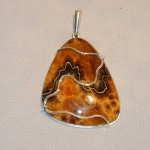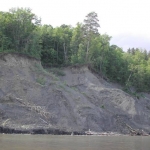Articles
HAUTERIVIAN AMMONITES OF THE ULYANOVSK REGION, AS JOBBING - JEWELER MATERIAL
D. A. Petrochenkov
Moscow State Geology and Prospecting University, Moscow, Russia
A. M. Natarius
Ulyanovsk, Russia
In the article there is some historical information on the usage of ammonites provided. Detailed mineralogical examination of typical samples has been carried out by means of radiographical and microprobe analyses and an electron microscope; the hardness has been determined. The most common minerals the ammonite consists of are calcite, aragonite and pyrite. Despite the relatively simple mineral composition, the ammonite stands out for the large amount of trace contaminant, various texture and structure features and the wide range of color tints, which produce unique patterns in jewelry.
INTRODUCTION
Ammonites rate as Cephalopoda and have an external cameo-shell. Fossil Cephalopoda represent the wide range of forms with numerous markers which give an opportunity to divide a geological chronology into both large and the smallest units [3]. Ammonites as jobbing-jeweler material together with belemnites, pearls, corals and mother of pearl fall under hydrogenous bio-mineral units [2].
Ammonite has been known to human from the earliest times. The Roman writer and scientist Pliny the Elder (23-79 C.E.) wrote in his «Natural history» that ammonite «…was one of the most sacred stones in Ethiopia in the shape of a ram’s horn with golden dyeing». In the eyes of the ancients these petrified remains were symbolic of the god Amon Cadmian. The cult of Amon was extremely widespread in temples of the Egyptian Middle Kingdom (about 2 thousand years B.C.E.). Sacrificers declared him as one of incarnations of the god Ra who was the all father of the whole Egyptian pantheon. They began calling him Amon-Ra [4].
With expansion of the Christian faith the pagan charms and amulets received the Christian symbols. These also include ammonite which is connected with the name of the Saint Hilda who was the first head of the Whitby Abbey (656) north-east of England. As a consequence of her prayers venomous snakes disturbing local residents began birdcaging, diving from cliffs and calcifying. From then onward ammonites are also known as stones of the Saint Hilda and they gained reputation as therapeutic ones [4]. Afanasy Nikitin also mentioned ammonites in his note which is referred to as «Walking beyond three seas». When travelling to India in 1471-1474 Nikitin together with gem stones seen by him in Silyan (Ceylon) named also ammones [1].
Last decades articles made of ammonites began having a great run. Ammonites are attractive because of their original form, dyeing and age of petrified remains measured as many tens of millions of years (Fig.1, 2). At the present time the bulk material in the Russian market is supplied from Hauterivian deposits of Ulyanovsk region.
RESEARCH METHODS
”Our company collects raw gemstones on the right riverside of Volga (Kuybyshev water storage reservoir) in the vicinity of Ulyanovsk. The section is characterized with high bold coasts, stacked marine sediments of jura and cretaceous. Hauterivian deposits of the lower cretaceous are represented with dark grey clays with a capacity of about 80m (Fig.3). In deposits there are ammonites of Speetoniceras Spath, Graspedodiscus Spath and Sinbirskites Pavlov geniuses.
All analytical investigations were executed in laboratories of the All-Russian scientific research institute of mineral resources. Semiquantative spectral analysis by spilling method was executed at 48 elements from powdered samples. Diagnostics of mineral ammonites was executed on X-ray diffractometer Хо Pert PRO (Philips). Definition of elemental composition of ammonites in local points was executed on electron probe analytical sets Superprobe 8100 (Jcob, Japan) and Inca-400 (Oxford Instruments, Great Britain). Microhardness of minerals was determined on the microhardness tester ПМТ-3 with the load 20g for carbonates, 100g for pyrite and exposition of 10sec. Electron-microscopic study of samples was executed on the transmission electron microscope Tesla BS-540 (Czechoslovakia) and the scanning electron microscope Tesla BS-301 (Czechoslovakia) equipped with X-ray spectrometer with energy dispersion.
RESEARCH RESULTS
Figure of articles made of ammonite fragments is based on the composition of the cameo-shell. The following series of components can be marked in the ammonite according to the mineral composition and textural features: chambers more or less filled in with the mineral substance; interior partitions; interior walls and exterior surface of the cameo-shell.
In accordance with data of the X-ray analysis base minerals forming parts of the ammonite are pyrite, magnesian calcite, aragonite making the pearl layer. In separate samples were also detected hematite, dolomite, quartz, chabasite in small amounts .
In accordance with data of the X-ray analysis gas chambers of the ammonite are more or less filled in with magnesian calcite of yellow, orange, brown, white and grey colors of different dyeing. The color of calcite and textural features of filling can essentially vary even in adjacent chambers. Filling texture can be blocked-mosaic, spherical, massive. In separate sections chamber partitions can be destroyed and their fragments are distributed inside it in a random way forming breccia texture. Often chambers are partially filled in with calcite or there is no calcite at all. As consequence geodes are formed. In case of absence of calcite chamber walls are made of pyrite.
Composition of chamber interior partitions can vary. In accordance with data of the X-ray analysis generally there is a thin (0,1-0,3mm) arched vein made of aragonite of light grey color with a pearl shine in the central part of the chamber. This vein crosses the whole chamber from interior to exterior walls. Often calcite veins of grey-brown color adjoin it symmetrically on both sides. Total width with the central vein amounts about 2mm. Generally veins of dark-brown calcite are framed with pyrite veins up to 1mm in width.
Research of thin sections showed that calcite filling chambers generally consists of long prismatic, lance-shaped and needle crystals forming sparry, radially fibrous, sheaf-like aggregates with distinctive undulatory zone. Structures are fibroblasting or fibrolytic (Fig.4-9). Dimensions of crystals usually range within 0,05-0,6mm and sometimes they are increased up to 1-3mm. Polysynthetic twinning is possible (Fig.6). Sometimes calcite is coarse-grained with angular forms (Fig.4). Separate crystals are several mm in sizes. Structure of these sections is granoblasting. Often blocks of calcite aggregates are oriented in different directions. This fact increases the variety of forms of crystals in the thin section.
Aragonite veins represent fragments of the pearl layer of the cameo-shell. They are made of fibrous-needle and often of fine-grained crystals (Fig.4,7,9). Generally aragonite veins are surrounded with fine-grained (0,1-0,05mm) crystals of calcite of isometric form. Presence of organic substance in the form of light shot is typical (Fig.4).
Marlstone represents lithified marine sediments. It is made of thin-crystal calcite located in the intergrowth with clay minerals. It consists of numerous dirts of glauconite, organic substance and ore minerals (pyrite). Structure is fine-grained, pelitic (Fig.9).
According to data of spectral analysis calcite from ammonites contains high concentration of impurity elements Mg, Fe, Mn. Higher test sensitivity helped to determines Si, Al, Ti, P, Na, Sr. Pyrite contains high concentration of Si, Al, Mg, Ca.
Elemental composition of ammonites in carbonates can essentially vary in different points but in average it is possible to mark the following tendencies (Tab.2). Aragonite of the pearl layer as distinct from the calcite contains several times less Mg, Mn, Fe and more Na. For the dirt of the organic substance high concentration of P is typical. Concentration of elements and exterior characteristics of calcite depend largely on its position in the ammonite. Lower concentration of Fe and higher concentration of P and Mn is typical for dark-brown veins in the chamber partition directly adjacent to aragonite layer. Calcite in ammonite chambers vice versa contains more Fe and less Mn and P. Calcite of exterior wall of the ammonite is set off with the material dispersion of values of analyzed elements but in average they are medium among calcites mentioned above.
Submicroscopic research of ammonite samples showed the matrix is made of blocks and small blocks with typical disintegration structures. Micronic lamination of blocks often consist of smaller parts with microinch in thickness (Fig.10,11). Recrystallization and desalination process led to the throw of series of elements forming their own microphases.
The following microinclusions were detected: calcium oxides, algodonite (Ca3As), pyrolusite, pyrite, quartz, ferrihydrite, apatite, vernadite, spinel, uranium oxide, fine-grained graphitization, calcite, gothite, bacteria impregnated with calcite oxide, ferrum and managnese, «fresh» bacteria. Parts of aragonite pearl layer in the shape of a scale of microinch in thickness are preserved (Fig.11-15).
Microhardness of calcites fluctuates within 235-301kgs/mm2. Microhardness of aragonite in chamber partitions of ammonites is several times lower and amounts in average 195kgs/mm2. Microhardness of pyrite fluctuates from 824 to 1290kgsmm2. Main quantity of measurements is within 1150-1200kgs/mm2.
CONCLUSION
Despite long historical reputation ammonites only since recently have been widely used for producing jewelry. This fact explains their weak gemological study. Executed researches showed that main minerals forming pseudomorphs in the ammonite cameo-shell are calcite and pyrite. Aragonite of the pearl layer as the chamber partition and the part of exterior surface of the cameo-shell preserved its mineral form. Other minerals were found in limited quantities. Seldom dirts of dolomite, hematite, quartz and chabasite were also detected. Despite relatively simple mineral composition ammonites are characterized with a great amount of microelements phases found in the course of submicroscopic research of samples. Ammonite minerals are characterized with a color variety and a wide range of texture and structure features. These all assign a unique image for articles made of ammonites.
LIST OF REFERENCE
1. Bobylev V. V. Indian precious and semiprecious stones as viewed by Afanasy Nikitin. Bulletin of gemology, 2003, №1(8), p.56-59
2. Bukanov V. V. Colored stones. Gemological dictionary, S.-P., 2001, p.208
3. Mikhaylova I. A., Bondarenko O.B. Paleontology. 4.1., M., Course book of MSU, 1997, p.448
4. Walters Rayond J. P. All about precious stones. Translation from English., M., BMM AO, 1999, p.160










